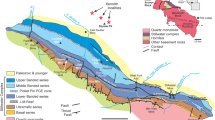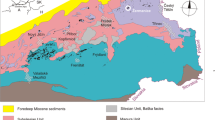Abstract
Re-mapping of the Alnö complex has radically reduced the area identified as fenite, in comparison with the classic work of Eckermann (1948). A marginal fenite zone, generally 500–600 m wide, is present around the complex, and the petrography and mineralogy of six selected key areas have been investigated in detail. Fenitization of the country rock migmatitic gneiss led to replacement of quartz, feldspars, biotite and chlorite by alkali pyroxene and amphibole, new generations of feldspars, calcite, titanite, fluorite and apatite. In some areas, however, a distinctive narrow band of fenitization, referred to as ‘contact fenite’, adjacent to large sövite dykes, contains mineral assemblages that include phlogopite, nepheline, melanite and wollastonite. Amphiboles in the fenites are richterite, katophorite, arfvedsonite and eckermannite. There is a very wide variation in the composition of pyroxenes which vary between diopside, aergirine-augite and aergirine. Although trends from aergirine to aegirine-augite and aegirine-augite to diopside have been defined, which are similar to those of other fenite localities, distinctive trends for the eastern part of the aureole have been identified that converge on aegirine, and approximate trends in some series of alkaline igneous rocks. Analyses of mica, garnet, wollastonite and feldspar are also presented and discussed. The mineralogical data are used to estimate the conditions of temperature, oxidation state, and activity of CO2, H2O and silica pertaining during the fenitization process. The fluids with which the fenites equilibrated were apparently different in composition in different parts of the aureole, and varied with time, implying more than one magmatic source. The various evolutionary trends identified in the pyroxenes and amphiboles, in particular, are explained in terms of two main fluid types, which emanated from ijolitic and carbonatitic magma sources.
Similar content being viewed by others
References
Bachinski SW, Müller G (1971) Experimental determinations of the microline — low albite solvus. J Petrol 12:329–356
Bailey DK (1966) Potash feldspar and phlogopite as indices of temperature and partial pressure of CO2 in carbonatite and kimberlite. IMA Pap Proc 4th Gen Meet, New Delhi pp 5–8
Bernotat WH, Morteani G (1982) The microcline/sanidine transformation isograd in metamorphic regions: Western Tauern Window and Merano-Mules-Anterselva complex (Eastern Alps). Am Mineral 67:43–53
Bowman JR, Essene EJ (1982) P-T-X(CO2) conditions of contact metamorphism in the Black Butte aureole, Elkhorn, Montana. Am J Sci 282:311–342
Brueckner HK, Rex DC (1980) K-A and Rb-Sr geochronology and Sr isotopic study of the Alno alkaline complex, northeastern Sweden. Lithos 13:111–119
Cameron M, Papike JJ (1979) Amphibole crystal chemistry: a review. Fortschr Mineral 57:28–67
Carmichael ISE, Turner FJ, Verhoogen J (1974) Igenous petrology. McGraw-Hill, New York
Charles RW (1975) The phase equilibria of richterite and ferrorichterite. Am Mineral 60:367–374
Charles RW (1977) The phase equilibria of intermediate compositions on the pseudobinary Na2CaMg5Si8O22(OH)2-Na2CaFe-5Si8O22(OH)2. Am J Sci 277:594–625
Czamanske CK, Atkin SA (1985) Metasomatism, titanian acmite, and alkali amphiboles in lithic-wacke inclusions within the Coyote Peak diatreme, Humboldt County, California. Am Mineral 70:499–516
Deer WA, Howie RA, Zussman J (1963) Rock forming minerals, 2. Chain Silicates. Longmans, London
Eckerman H (1948) The alkaline district of Alnö Island. Sver Geol Unders Ca 36:1–176
Eckermann H (1958) The alkaline and carbonatitic dikes of the Alnö Formation on the mainland north-west of Alnö Island. Kungl Svenska Vetens Hand 7:1–64
Eckermann H (1966) Progress of research of the Alnö carbonatite. In: Tuttle OF, Gittins J (eds) Carbonatites. Interscience, New York, pp 3–31
Eckermann H (1974) The chemistry and optical properties of some minerals of the Alnö alkaline rocks. Arkiv Mineral Geol 5(8):93–210
Eckermann H, Wickman FE (1956) A preliminary determination of the maximum age of the Alnö rocks. Geol Foren Forh 78:122–124
Ernst WG (1962) Synthesis, stability relations, and occurrence of riebeckite and riebeckite-arfvedsonite solid solution. J Geol 70:689–736
Ernst WG (1976) Petrologic phase equilibria. Freeman, San Francisco
Flower MFJ (1974) Phase relations of titan-acmite in the system Na2O-Fe2O3-Al2O3-TiO2 at 1000 bars total water pressure. Am Mineral 59:536–548
Gibb FGF (1973) The zoned clinopyroxenes of the Shiant Isles Sill, Scotland. J Petrol 14:203–230
Giret A, Bonin B, Leger J-M (1980) Amphibole compositional trends in oversaturated alkaline plutonic ring-complexes. Can Mineral 18:481–495
Hamilton DL (1961) Nephelines as crystallization temperature indicators. J Geol 69:321–329
Kresten P (1976) A magmatic survey of the Alno complex. Geol Foren Forh 98:361–362
Kresten P (1979) The Alnö complex: discussion of the main features, bibliography and excursion guide. Nordic Carbonatite Symposium, 67 pp
Kresten P (1980) The Alno complex; tectonics of dyke emplacement. Lithos 13:153–158
Kresten P (1986a) Map of the Alnö complex. Sveriges Geologiska Undersökning, Ser Ba nr 31, Specialkarta 1
Kresten P (1986b) Alkaline and carbonatitic Alnö dikes. Sveriges Geologiska Undersökning, Ser Ba nr 31, Specialkarta 2
Kresten P, Morogan V (1986) Fenitization at the Fen complex, southern Norway. Lithos 19:27–42
Kresten P, Printzlau I, Rex D, Vartiainen H, Woolley AR (1977) New ages of carbonatitic and alkaline ultramafic rocks from Sweden and Finland. Geol Foren Forh 99:62–5
Kretz R (1983) Symbols for rock-forming minerals. Am Mineral 68:277–279
Larsen LM (1976) Clinopyroxenes and coexisting mafic minerals from the alkaline Ilimaussaq intrusion, South Greenland. J Petrol 17:258–290
Leake BE (1978) Nomenclature of amphiboles. Mineral Magm 42:533–563
Le Bas MJ (1977) Carbonatite-nephelinite volcanism. New York
Wiley McKie D (1966) Fenitization. In: Tuttle OF, Gittins J (eds) Carbonatites. Interscience, New York, pp 261–294
Merrill RB, Robertson JK, Wyllie PJ (1970) Melting relations in the system NaAlSi3O8-KalSi3O8-SiO2-H2O to 20 kbars, compared with results for other feldspar-quartz-H2O and rock-H2O systems. J Geol 78:558–569
Mian J, Le Bas MJ (1986) Sodic amphiboles in fenites from the Loe Shilman carbonatite complex, NW Pakistan. Mineral Magm 50:187–197
Mitchell RH (1980) Pyroxenes of the Fen alkaline complex, Norway. Am Mineral 65:45–54
Mitchell RH, Platt RG (1978) Mafic mineralogy of ferroaugite syenite from the Coldwell alkaline complex, Ontario, Canada. J Petrol 19:627–651
Nicholls J, Carmichael ISE, Storner JC Jr (1971) Silica activity and Ptotal in igneous rocks. Contrib Mineral Petrol 33:1–20
Platt RG, Woolley AR (1986) The mafic mineralogy of the peralkaline syenites and granites of the Mulanje complex. Malawi. Mineral Magm 50:85–99
Rubie DC, Gunter WD (1983) The role of speciation in alkaline igneous fluids during fenite metasomatism. Contrib Mineral Petrol 82:165–175
Soderstrom L (1966) The kimberlites of Avike Bay, on the Bothnian coast of Sweden. Geol Foren Forh 88:351–360
Strong DF, Taylor RP (1984) Magmatic-subsolidus and oxidation trends in composition of amphiboles from silica-saturated peralkaline igneous rocks. Tschermaks Mineral Petrog Mitt 32:211–222
Sutherland DS (1969) Sodic amphiboles and pyroxenes from fenites in east Africa. Contrib Mineral Petrol 24:114–135
Vartiainen H, Woolley AR (1976) The petrography, mineralogy and chemistry of the fenites of the Sokli carbonatite intrusion, Finland. Geol Surv Finland Bull 280:1–87
Verhoogen J (1962) Distribution of titanium between silicates and oxides in igneous rocks. Am J Sci 260:211–220
Wones DR, Eugster HP (1965) Stability of biotite: experiment, theory and application. Am Mineral 50:1228–1272
Yagi K (1966) The system acmite-diopside and its bearing on the stability relations of natural pyroxenes of the acmite-hedenbergite-diopside series. Am Mineral 51:976–999
Yund RA (1975) Microstructure, kinetics, and mechanisms of alkali feldspar exolution. Rev Mineral 2:29–54
Author information
Authors and Affiliations
Rights and permissions
About this article
Cite this article
Morogan, V., Woolley, A.R. Fenitization at the Alnö carbonatite complex, Sweden; distribution, mineralogy and genesis. Contrib Mineral Petrol 100, 169–182 (1988). https://doi.org/10.1007/BF00373583
Received:
Accepted:
Issue Date:
DOI: https://doi.org/10.1007/BF00373583




